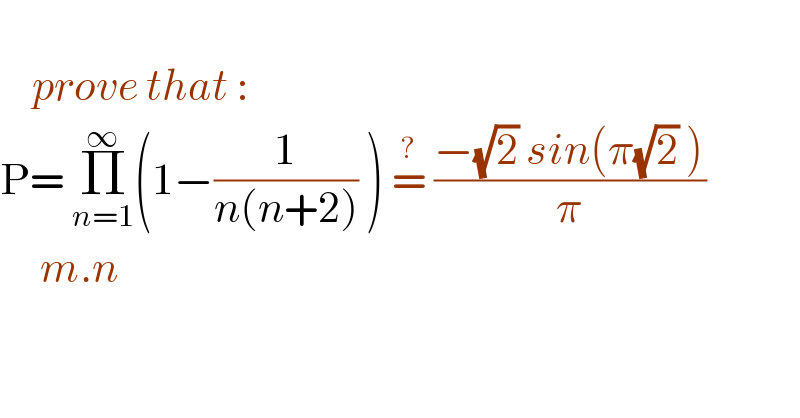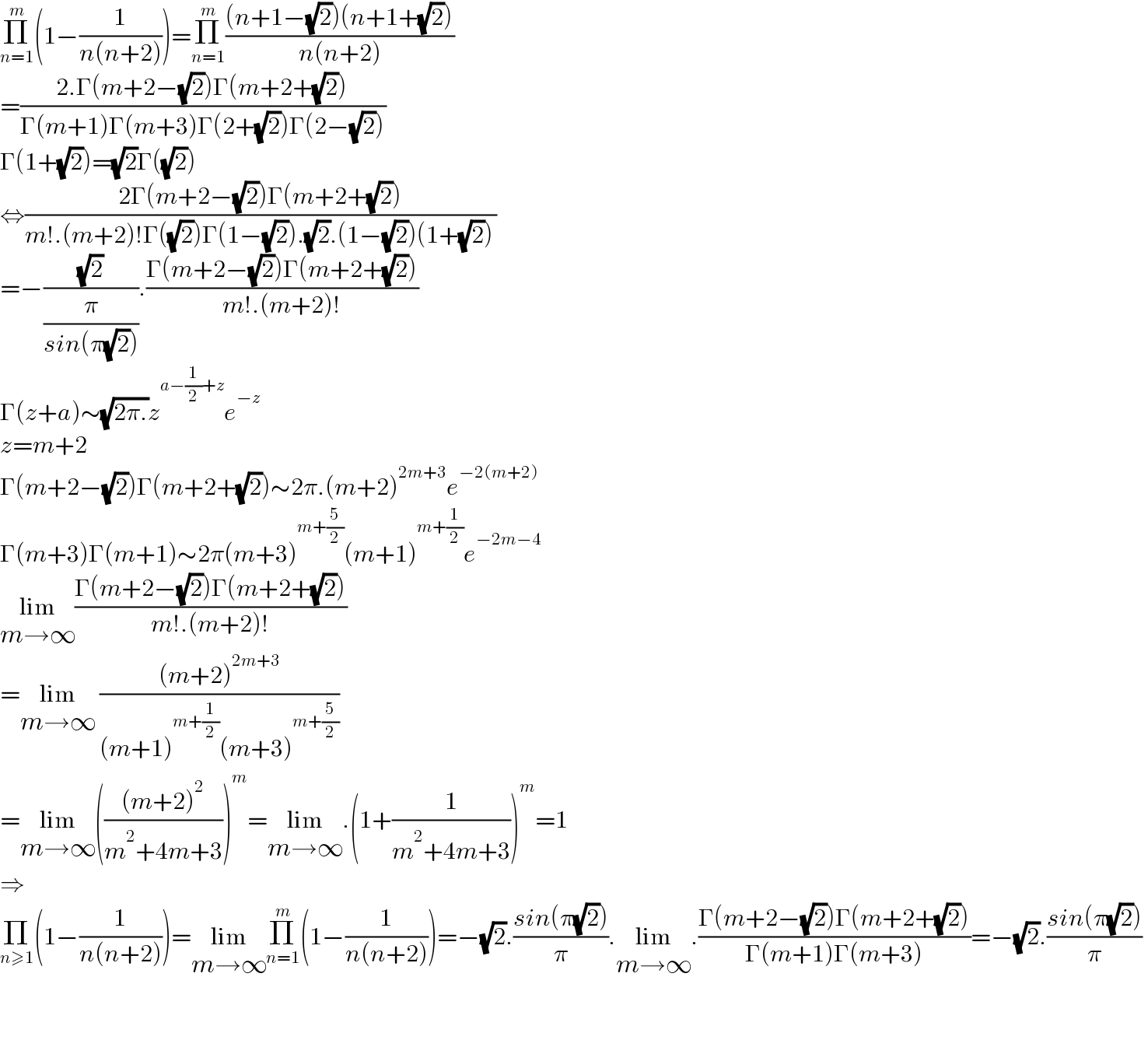
Question Number 159681 by mnjuly1970 last updated on 20/Nov/21

$$ \\ $$$$\:\:\:\:{prove}\:{that}\:: \\ $$$$\mathrm{P}=\:\underset{{n}=\mathrm{1}} {\overset{\infty} {\prod}}\left(\mathrm{1}−\frac{\mathrm{1}}{{n}\left({n}+\mathrm{2}\right)}\:\right)\:\overset{?} {=}\:\frac{−\sqrt{\mathrm{2}}\:{sin}\left(\pi\sqrt{\mathrm{2}}\:\right)}{\pi} \\ $$$$\:\:\:\:\:{m}.{n} \\ $$
Answered by mindispower last updated on 21/Nov/21

$$\underset{{n}=\mathrm{1}} {\overset{{m}} {\prod}}\left(\mathrm{1}−\frac{\mathrm{1}}{{n}\left({n}+\mathrm{2}\right)}\right)=\underset{{n}=\mathrm{1}} {\overset{{m}} {\prod}}\frac{\left({n}+\mathrm{1}−\sqrt{\mathrm{2}}\right)\left({n}+\mathrm{1}+\sqrt{\mathrm{2}}\right)}{{n}\left({n}+\mathrm{2}\right)} \\ $$$$=\frac{\mathrm{2}.\Gamma\left({m}+\mathrm{2}−\sqrt{\mathrm{2}}\right)\Gamma\left({m}+\mathrm{2}+\sqrt{\mathrm{2}}\right)}{\Gamma\left({m}+\mathrm{1}\right)\Gamma\left({m}+\mathrm{3}\right)\Gamma\left(\mathrm{2}+\sqrt{\mathrm{2}}\right)\Gamma\left(\mathrm{2}−\sqrt{\mathrm{2}}\right)} \\ $$$$\Gamma\left(\mathrm{1}+\sqrt{\mathrm{2}}\right)=\sqrt{\mathrm{2}}\Gamma\left(\sqrt{\mathrm{2}}\right) \\ $$$$\Leftrightarrow\frac{\mathrm{2}\Gamma\left({m}+\mathrm{2}−\sqrt{\mathrm{2}}\right)\Gamma\left({m}+\mathrm{2}+\sqrt{\mathrm{2}}\right)}{{m}!.\left({m}+\mathrm{2}\right)!\Gamma\left(\sqrt{\mathrm{2}}\right)\Gamma\left(\mathrm{1}−\sqrt{\mathrm{2}}\right).\sqrt{\mathrm{2}}.\left(\mathrm{1}−\sqrt{\mathrm{2}}\right)\left(\mathrm{1}+\sqrt{\mathrm{2}}\right)} \\ $$$$=−\frac{\sqrt{\mathrm{2}}}{\frac{\pi}{{sin}\left(\pi\sqrt{\mathrm{2}}\right)}}.\frac{\Gamma\left({m}+\mathrm{2}−\sqrt{\mathrm{2}}\right)\Gamma\left({m}+\mathrm{2}+\sqrt{\mathrm{2}}\right)}{{m}!.\left({m}+\mathrm{2}\right)!} \\ $$$$\Gamma\left({z}+{a}\right)\sim\sqrt{\mathrm{2}\pi.}{z}^{{a}−\frac{\mathrm{1}}{\mathrm{2}}+{z}} {e}^{−{z}} \\ $$$${z}={m}+\mathrm{2} \\ $$$$\Gamma\left({m}+\mathrm{2}−\sqrt{\mathrm{2}}\right)\Gamma\left({m}+\mathrm{2}+\sqrt{\mathrm{2}}\right)\sim\mathrm{2}\pi.\left({m}+\mathrm{2}\right)^{\mathrm{2}{m}+\mathrm{3}} {e}^{−\mathrm{2}\left({m}+\mathrm{2}\right)} \\ $$$$\Gamma\left({m}+\mathrm{3}\right)\Gamma\left({m}+\mathrm{1}\right)\sim\mathrm{2}\pi\left({m}+\mathrm{3}\right)^{{m}+\frac{\mathrm{5}}{\mathrm{2}}} \left({m}+\mathrm{1}\right)^{{m}+\frac{\mathrm{1}}{\mathrm{2}}} {e}^{−\mathrm{2}{m}−\mathrm{4}} \\ $$$$\underset{{m}\rightarrow\infty} {\mathrm{lim}}\frac{\Gamma\left({m}+\mathrm{2}−\sqrt{\mathrm{2}}\right)\Gamma\left({m}+\mathrm{2}+\sqrt{\mathrm{2}}\right)}{{m}!.\left({m}+\mathrm{2}\right)!} \\ $$$$=\underset{{m}\rightarrow\infty} {\mathrm{lim}}\:\frac{\left({m}+\mathrm{2}\right)^{\mathrm{2}{m}+\mathrm{3}} }{\left({m}+\mathrm{1}\right)^{{m}+\frac{\mathrm{1}}{\mathrm{2}}} \left({m}+\mathrm{3}\right)^{{m}+\frac{\mathrm{5}}{\mathrm{2}}} } \\ $$$$=\underset{{m}\rightarrow\infty} {\mathrm{lim}}\left(\frac{\left({m}+\mathrm{2}\right)^{\mathrm{2}} }{{m}^{\mathrm{2}} +\mathrm{4}{m}+\mathrm{3}}\right)^{{m}} =\underset{{m}\rightarrow\infty} {\mathrm{lim}}.\left(\mathrm{1}+\frac{\mathrm{1}}{{m}^{\mathrm{2}} +\mathrm{4}{m}+\mathrm{3}}\right)^{{m}} =\mathrm{1} \\ $$$$\Rightarrow \\ $$$$\underset{{n}\geqslant\mathrm{1}} {\prod}\left(\mathrm{1}−\frac{\mathrm{1}}{{n}\left({n}+\mathrm{2}\right)}\right)=\underset{{m}\rightarrow\infty} {\mathrm{lim}}\underset{{n}=\mathrm{1}} {\overset{{m}} {\prod}}\left(\mathrm{1}−\frac{\mathrm{1}}{{n}\left({n}+\mathrm{2}\right)}\right)=−\sqrt{\mathrm{2}}.\frac{{sin}\left(\pi\sqrt{\mathrm{2}}\right)}{\pi}.\underset{{m}\rightarrow\infty} {\mathrm{lim}}.\frac{\Gamma\left({m}+\mathrm{2}−\sqrt{\mathrm{2}}\right)\Gamma\left({m}+\mathrm{2}+\sqrt{\mathrm{2}}\right)}{\Gamma\left({m}+\mathrm{1}\right)\Gamma\left({m}+\mathrm{3}\right)}=−\sqrt{\mathrm{2}}.\frac{{sin}\left(\pi\sqrt{\mathrm{2}}\right)}{\pi} \\ $$$$ \\ $$$$ \\ $$
